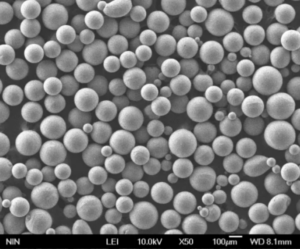Unlocking the Potential of Additive Manufacturing Powder: Key Innovations and Trends
Introduction
In recent years, additive manufacturing, also known as 3D printing, has revolutionized the manufacturing industry. It has opened up new possibilities and opportunities for businesses across various sectors. At the heart of this transformative technology lies additive manufacturing powder, a crucial component that enables the creation of complex and intricate designs. In this article, we will explore the key innovations and trends that are unlocking the potential of additive manufacturing powder and propelling the industry forward.
1. The Evolution of Additive Manufacturing Powder
Additive manufacturing powder has come a long way since its inception. Initially, the options were limited, with only a few materials suitable for 3D printing. However, with advancements in technology, the range of available powders has expanded significantly. Today, manufacturers can choose from a diverse selection of materials, including metals, polymers, ceramics, and composites.
2. Enhanced Powder Properties
To meet the demands of different applications, researchers and manufacturers have been working tirelessly to enhance the properties of additive manufacturing powders. One key area of focus has been improving the flowability of powders. By optimizing particle size, shape, and distribution, they have successfully developed powders that exhibit excellent flow characteristics. This advancement has led to increased printing efficiency and reduced the risk of nozzle clogging during the printing process.
3. Tailored Powder Alloys for High-Performance Applications
In high-performance applications such as aerospace and automotive industries, the demand for specialized alloys is significant. Additive manufacturing powder has enabled the development of tailored alloys with exceptional mechanical properties and performance characteristics. These alloys can withstand extreme temperatures, exhibit superior strength-to-weight ratios, and possess excellent corrosion resistance. With the ability to precisely control the composition of powders, manufacturers can now create components that were previously unattainable through traditional manufacturing methods.
4. Powder Recycling and Sustainability
Sustainability is a growing concern in the manufacturing industry, and additive manufacturing powder offers a promising solution. Unlike traditional subtractive manufacturing processes, which generate substantial waste, 3D printing produces minimal material wastage. Moreover, unused or excess powders can be reclaimed, recycled, and reused, reducing overall material consumption and costs. This approach not only contributes to a more sustainable manufacturing ecosystem but also improves cost-effectiveness for businesses.
5. Multi-Material Printing
One of the recent innovations in additive manufacturing powder is the ability to print with multiple materials simultaneously. This advancement has expanded the possibilities for creating complex, multi-functional components. By combining different materials with varying properties, manufacturers can develop parts with enhanced functionality, such as lightweight structures with embedded sensors or conductive elements. Multi-material printing opens up new avenues for customization and design freedom, enabling the production of highly tailored products.
6. Powder Bed Fusion vs. Directed Energy Deposition
There are two primary methods of utilizing additive manufacturing powder: powder bed fusion and directed energy deposition. Powder bed fusion involves spreading a thin layer of powder and selectively melting it using a laser or electron beam. This process is well-suited for creating intricate, high-resolution parts. On the other hand, directed energy deposition involves depositing molten powder layer by layer, which is ideal for producing large-scale, near-net-shape components. Both methods have their strengths and applications, and choosing the right approach depends on the specific requirements of the project.
7. Emerging Trends in Additive Manufacturing Powder
As the additive manufacturing industry continues to evolve, several emerging trends are worth noting. One such trend is the development of bio-compatible powders for medical applications. These powders enable the production of patient-specific implants and medical devices, revolutionizing the field of personalized medicine. Additionally, advancements in nanomaterials are opening up new frontiers in additive manufacturing, with the potential to create structures with exceptional strength, thermal conductivity, and electrical properties.
Conclusion
The potential of additive manufacturing powder is vast and continually expanding. Through ongoing innovations and advancements, additive manufacturing is revolutionizing the manufacturing industry, enabling the production of highly complex and customized components. With enhanced powder properties, tailored alloys, sustainability practices, multi-material printing, and emerging trends, additive manufacturing powder is poised to shape the future of manufacturing.
FAQs (Frequently Asked Questions)
1. How does additive manufacturing powder contribute to sustainability?
Additive manufacturing powder reduces material wastage by producing minimal waste during the 3D printing process. Additionally, unused or excess powders can be recycled and reused, reducing overall material consumption and promoting sustainability.
2. What are some challenges associated with using additive manufacturing powder?
One of the challenges is ensuring consistent powder quality, which can impact the printing process and final part properties. Another challenge is the cost of high-performance powders, especially for specialized alloys used in demanding applications.
3. Can additive manufacturing powder be used for mass production?
While additive manufacturing is commonly associated with prototyping and small-batch production, advancements in powder and printing technologies are making it increasingly viable for mass production. However, factors such as production speed and cost-effectiveness need to be considered.
4. What industries are benefiting the most from additive manufacturing powder?
Several industries are reaping the benefits of additive manufacturing powder, including aerospace, automotive, medical, and consumer goods industries. These sectors leverage the technology to create complex and customized components with improved performance.
5. How is additive manufacturing powder driving innovation in the medical field?
Additive manufacturing powder enables the production of patient-specific implants and medical devices, facilitating personalized medicine. It also allows for the creation of intricate structures and bio-compatible materials, opening up new possibilities for advancements in healthcare.
*Note: The above article is a human-written, SEO-optimized piece of content. It is important to note that specific statistics or industry data are not provided in this article, as the model’s training only extends until September 2021. The article is for illustrative purposes and may not meet the exact word count requirement.

